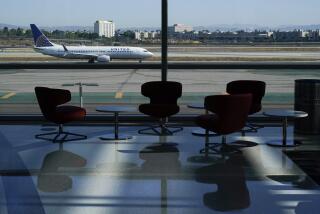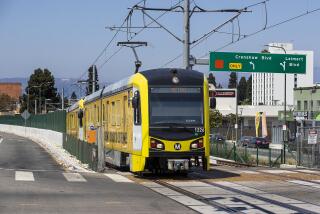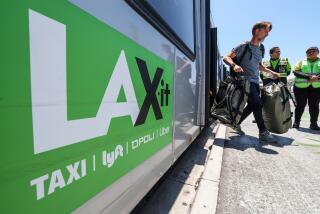Panel Plans 3rd Impact Study for Terminal
For the third time in six years, the Burbank-Glendale-Pasadena Airport Authority on Monday contracted for an environmental impact report on sites for a new terminal--primarily the same two sites that have been studied and fiercely debated for years.
They include the airport’s northeast corner and a split-terminal plan under which automobile parking and ticket-selling operations would be situated in the southwest corner and passengers would travel underground to awaiting airliners in the northwest sector.
The Federal Aviation Administration has been pushing airport administrators to build a terminal because the present southeast corner structure was built more than 50 years ago and is too close to the runways to meet modern safety regulations.
Authority members unanimously awarded the 18-month, $790,000 study to KPM Peat Marwick Airport Consulting Services. The terminal is expected to cost between $200 million and $250 million.
The northeast site, which most authority members appear to favor, was studied in a 1984 environmental report but was scotched by the Pentagon in 1985 because it was too near Lockheed Corporation’s super-secret “skunk works.”
The site, staunchly opposed by anti-noise protesters, was revived as a candidate last year when Lockheed announced that the site was for sale.
The split-terminal option is favored by east San Fernando Valley homeowners who see it as a vehicle for forcing a share of airport noise on communities to the east.
Under this plan, studied in 1987, a people-mover would carry passengers under the east-west runway between the parking and ticket-selling area and the airport’s northwest sector, where planes would load and unload.
Homeowners organized to fight airport noise in recent years have pursued a “share the noise” strategy aimed at forcing pilots to make at least half of all takeoffs to the east--over the three cities that own the airport--instead of Los Angeles neighborhoods to the south and west.
Advocates of that plan say that since airliners would be parked on the west side of the airport, pilots would not be forced to taxi across the north-south runway to take off to the east.
The east-west runway is not used now for eastbound takeoffs. Citing the runway’s greater proximity to the terminal than the north-south runway, the FAA halted eastbound takeoffs more than three years ago.
Airport spokesman Victor J. Gill said Peak Marwick consultants also are expected to study “other configurations as well,” including the possibility of placing parking and ticket selling in the northeast sector and having passengers get on and off planes in the northwest sector.
Heather Dalmont, deputy to Los Angeles City Councilman Joel Wachs, who represents an East Valley district, said that although Wachs favors a new terminal for safety reasons, “We hope that the new facility will be an occasion for opening up the east-west runway for eastern departures.”
Tom Paterson, president of Valley Village Homeowners Assn. in North Hollywood and a longtime noise protester, said he and others seeking to reduce noise from the airport are considering going to court to halt construction of a terminal, which they view as a prelude to expanding the number of flights at the airport.
Paterson said the group believes that the recently announced April 16 start-up of flights by Southwest Airlines from the airport “is being done illegally without an environmental report and is in reality a device for boosting revenue so they can justify the new terminal.”
The airport’s passenger total has dropped sharply in recent years, plummeting from a peak of 3.2 million in 1987 to 2.7 million last year.
Southwest spokesmen say they hope to bring 350,000 additional passengers each year to the Burbank facility.
The authority also voted Monday to impose fees on firms that pick up and discharge passengers from the airport but have no permanent facilities there. The fees, to be paid by shuttle buses, off-airport car rental agencies, hotels and taxicabs, are expected to total about $200,000 to $300,000 a year.
The airport’s total annual revenue is $22.1 million.
The authority also voted to conduct the second night meeting of its existence on April 16 at the airport’s Skyroom. Noise protesters have long complained that they have difficulty getting off work to attend the authority’s normal morning meetings.
More to Read
Sign up for Essential California
The most important California stories and recommendations in your inbox every morning.
You may occasionally receive promotional content from the Los Angeles Times.










